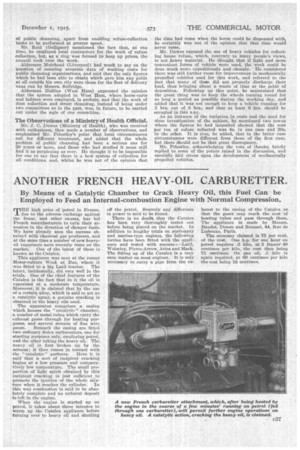ANOTHER FRENCH HEAVY-OIL CARBURETTER.
Page 21

If you've noticed an error in this article please click here to report it so we can fix it.
By Means of a Catalytic Chamber to Crack Heavy Oil, this Fuel Can be Employed to Feed an Internal-combustion Engine with Normal Compression,
THE high price of petrol in France, due to the adverse exchange against the franc, and other causes, has • led French manufacturers to turn their attention in the direction of cheaper fuels. We have already seen the success obtained with charcoal gas producers, and at the same time a number of new heavyoil vaporizers nave recently come on the market. One of the latest of these is known as the Catalex.
_ This appliance was seen at the recent Motor-culture Week at Buc, where it was fitted to a big Latil tractor. The latter, incidentally,, did very well in the trials. One of the chief features of the Catalex is the fact that in it the oil is vaporized at a moderate temperature. Moreover, it is claimed that by the use of a centain alloy, which is said to act as
• a catalytic agent, a genuine cracking is . obtained in the heavy oils used.
The apparatus comprises at casing which houses the " catalytic " charciber, a number of mehal tubes which carry the exhaust gases through for heating purposes, and several screens of fine wire gauze. Beneath the casing are fitted two ordinary Solex carburetters, one for starting purposes only, employing petrol, and the other taking the heavy oil. The heavy oil is first broken up by the screens; it then comes in contact with the "catalytic" surfaces. Here it is said that a sort of incipient cracking begins at a low pressure and comparatively low temperature. The small proportion of light spirit obtained by this incipient cracking is just sufficient to promote the ignition of the whole mixture when it reaches the cylinder. In thie way combustion is said to he absolutely complete and no unburnt deposit is left in the engine.
When the engine is started up on petrol, it takes about three minutes to • warm up the Catalex appliance before turning over to heavy oil and shutting off the petrol. Scarcely any difference in power is said to be found.
There is no doubt that the Catalex has been very thoroughly tested out before being placed on the market. In addition to lengthy trials on stationary and marine-type engines, the following lorries have been fitted with the appliance and tested with success :—Latil, Wolseley, Pierce-Arrow, Aries and Mack. The fitting up of the Catalex is a very easy matter on most engines. It is only necessary. to _carry a pipe from the ex
haust to the easing of the Catalex so that the gases may reaeh the nest of heating tubes and pass through them. The appliance is made by Messrs. Baudet, Donon and Roussel, 44, Rue de Lishonne, Paris.
• The economy claimed is 75 per cent. of the cost. One h.p. for one hour on petrol requires .3 kilo, at 2 francs, 40 centimes per kilo, the cast then being 72 centimes. On gas oil, .3 kilo is again required, at 60 centimes per kilo the cost being 1$ centimes.






























